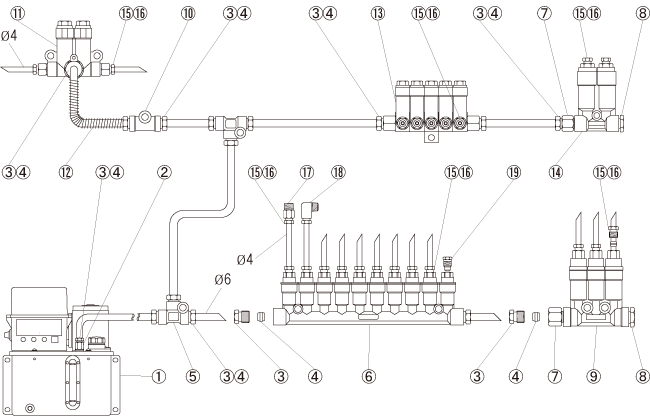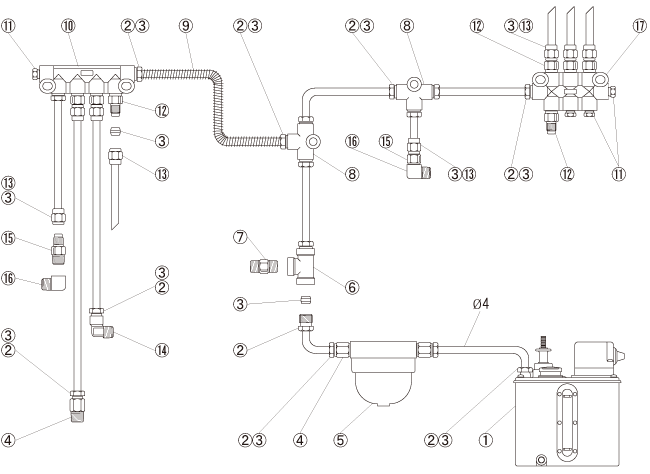System Outline
OIL LUBRICATION SYSTEMS
SHOWA oil lubrication systems comprises of 2 main sub-lubrication systems, offering different methods of distribution and discharge. Refer below to identify the lubrication system required for certain lubricating applications.
VOLUMETRIC SYSTEM
The volumetric type lubrication system focuses on applying measured volumes of oil to the multiple lubrication points on equipment or machinery.
The distribution equipment (Dester Plunger or Dester Block) measures a specified amount of oil and then proceeds to forward the lubricant intermittently to the lubrication points.
This accurate and intermittent distribution via the distribution equipment is induced by volumetric type pump.
Motorized lubrication pumps for this system, will run and halt in intermittent cycles through the use of a controlling mechanism (Eg. IC Timers).
Distribution equipment for the volumetric type system can be separated into 2 main categories.
Direct pump pressure or spring pressure induced discharge methods.
The first utilizes the pump’s discharge pressure to eject the oil from within the pistons. The later method utilizes the pump’s pressure to replenish the pistons with oil and relies on the internal spring to displace the oil.
As the displacement of pressure is required for the volumetric type distribution equipment to operate, all volumetric type pumps possess pressure displacement mechanisms.

| No. | Code | Description |
|---|---|---|
| 1 | - PUMP - | Volumetric Type |
| 2 | PD6 | Nipple |
| 3 | PA6 | Bushing |
| 4 | PB6 | Sleeve |
| 5 | PKD6 | T Connector |
| 6 | DPB110 | Dester Plunger |
| 7 | PD612 | Main Pipe Nipple |
| 8 | PG12 | Sealing Plug / Gasket |
| 9 | DPB23 | Dester Plunger |
| 10 | JD2-6 | Junction |
| No. | Code | Description |
|---|---|---|
| 11 | DSA2 | Dester Block |
| 12 | FSC605 | Flexible Hose |
| 13 | DSB5 | Dester Block |
| 14 | DPB32 | Dester Plunger |
| 15 | PA4 | Bushing |
| 16 | PB4 | Sleeve |
| 17 | PD4 | Nipple |
| 18 | PH4 | Elbow |
| 19 | PG004 | Sealing Plug |
RESISTANCE SYSTEM
By applying various levels of resistance at the resistance type distribution junctions or lubrication points, oil from the pump unit can be divided and discharged proportionally.
Through the selection of the pump unit and distribution equipment, oil can be discharged either intermittently or continuously at lubrication points.
Unlike the volumetric system, which allows specific volumes of oil to be discharged at lubrication points, the resistance type system is unable to measure exact volumes for discharge past the pump unit.
However, the resistance type system enables continuous lubrication, which has an added benefit of a cooling effect, making this system ideal where heat displacement is also a requirement along with general lubrication.
Another differing factor is, the volumetric system will only discharge the set capacity of oil from the pistons and will require the pump unit to halt and displace internal pressure before any more oil can be discharged at lubrication points.
In comparison, oil will continuously be discharged from the lubrication points in the resistance system, as long as the pump unit continues to operate.
As such, more emphasis is placed on the output capacity and control of the pump unit, in regards to discharge volumes at certain lubrication points.

| No. | Code | Description |
|---|---|---|
| 1 | - PUMP - | Resistance Type |
| 2 | PA4 | Bushing |
| 3 | PB4 | Sleeve |
| 4 | PD4 | Nipple |
| 5 | LF01N | Line Filter |
| 6 | JHD3 | Junction Head |
| 7 | PTT | Flow Proper Unit |
| 8 | JD3 | Junction |
| 9 | FHC420 | Flexible Hose |
| No. | Code | Description |
|---|---|---|
| 10 | DB6D | Dester Unit |
| 11 | PG004 | Sealing Plug |
| 12 | PSS | Flow Proper Unit |
| 13 | PAN4 | Proper Nut (Bushing) |
| 14 | PHD4 | Elbow |
| 15 | PST | Flow Proper Unit |
| 16 | PI1 | Elbow |
| 17 | DA8D | Dester Unit |

